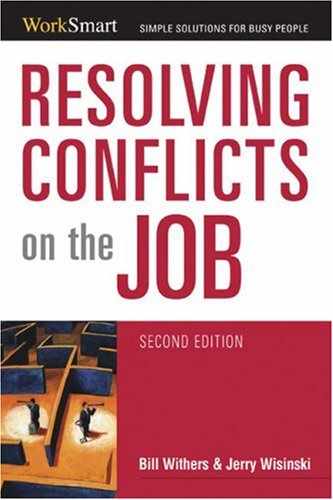Many people attend workshops on conflict because they want to know how to stay calm when someone else is being highly emotional. They often say, “I know what I’m supposed to say, but I have trouble staying calm enough to do the right thing. By the time I thought of what I should have said, I was at home, had dinner, and was lying in bed looking at the ceiling.” (This chapter is adapted from workshops run by Bill Withers and Keami Lewis as reported in their book The Conflict and Communication Activity Book.)
Some people seem to be better than others when it comes to knowing what to say and do under pressure. These individuals come across as unflappable, in control, maybe even wise. How do they do it?
There are many things that may help people stay unruffled in a conflict. One is that they have a lot of practice being in conflict situations. Another is that they feel reasonably sure that things will work out the way they want them to. A third way is that they are not upset because they have decided not to be upset.
Practice counts for a lot. Exercises like the ones in this book can help even very inexperienced people to invent new ways to respond to conflict. The more practice we have—in practice scenarios and in real life—the more nimble we are when a conflict seems to be about to boil over.
People can sometimes stay calm during a conflict when it is pretty clear that things will turn out okay. They may be confident in the outcome because of a powerful position they have. Sometimes a person feels that he or she is holding a trump card. This person may recognize this particular type of conflict or pattern and know that it is survivable and that all will be well in the end. What we will look at in this chapter is how to stay centered—that is, calm and relaxed while being able to make extremely rapid choices about what you will say and do.
Practice and experience are important and helpful when dealing with conflict, but they can come together to help you the most when—in the thick of things—you can calmly make effective choices about what to do.
Beyond the help that practiced strategies, experience, attitude, or even being powerful can give us is the ability to exercise what might be called controlled relaxation. Martial artists, yoga practitioners, and others refer to this ability to deliberately relax mind and body together at a moment’s notice and without thought as centering.
You may be surprised at what you already know about centering.
If you paint or draw, play a musical instrument, ski, golf, or play any sport, you probably already have been centering yourself from time to time. If you can tell a joke well without effort, or dance, or just automatically seem to know what piece to move on a checkerboard, you have probably been centering.
Centering is better than strategizing when you are in a conflict situation. With a strategy, you plan to do or say something based on your expectation of the other person’s action—“I’ll say ‘A,’ and he’ll say, ‘B.’ Then I’ll say ‘Z,’ and that’ll get him!” Of course, your carefully planned strategy goes right out the window if the other guy says “Z” (or something unexpected, like “LMNOP”) before you do.
Centering is a technique that leads to the abandonment of strategy in favor of allowing the appropriate choice of action or relationship with the other person to emerge.
Sound strange?
You have probably heard or read something about “fight or flight.” The idea is that our brains tend to react in one of two ways when we are under stress. For example, if we are in a conflict, we can either confront the other person (fight) or walk away and hope nothing else happens (flight). This may have worked pretty well for our ancestors. If you were confronted with a saber-toothed cat, for example, you would quickly either run away or hit it with something, depending on your preferences. Nowadays, when we are faced with a conflict, we can often sense our body getting ready for fight or flight—our muscles tense, our heart pumps a little harder, and we get an adrenaline rush.
This physical fight-or-flight reaction still happens when we are centered. The difference is that when we are centered, we are able to send this energy toward a third choice. Think about it: one choice is to fight, the other choice is to flee. Both can make things worse than they already are. When you are centered, you can calmly apply what you are learning about engaging conflict and make split-second adjustments depending on what will work best for you and the other person.
Like every other technique in this book, centering is a simple approach that can be very effective the more you practice it. The following exercise may be your first step toward staying cool in a conflict.
